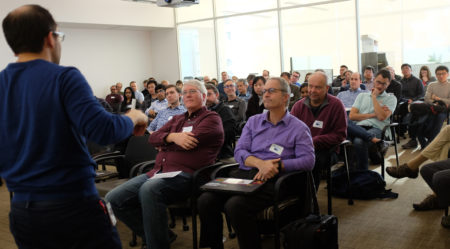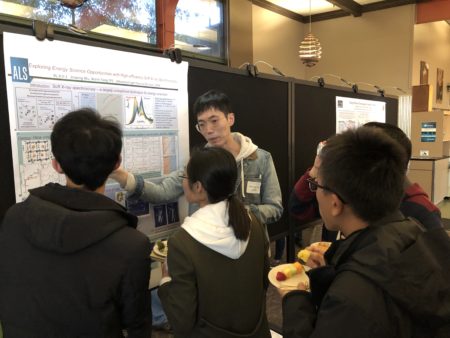
By Lori Tamura
About 80 Berkeley Lab scientists gathered at the ALS last week for an “ALS Water-Energy Outreach Forum” to discuss the challenges and opportunities arising from a growing focus on the nexus between water and energy—two resources essential to human populations—and to explore how the ALS can help address key questions in the field.
The term “water-energy nexus” gained currency among scientists and policy makers as it became increasingly clear that water, once considered cheap and abundant, is a critical yet potentially inconsistent resource involved in both the generation and consumption of energy. Great strides have been made on the energy side of the equation. Now, the water side is receiving attention. In 2018, the Department of Energy launched its Water Security Grand Challenge and announced plans to fund an Energy-Water Desalination Hub to address water security issues in the United States. Berkeley Lab had already established its own Water-Energy Resilience Research Institute (WERRI), a “community of researchers dedicated to advancing climate-resilient, energy-optimized solutions for a secure water future.”

To plug the ALS into these developments, the ALS Water-Energy Outreach Forum was organized by beamline scientists Ethan Crumlin and Jinghua Guo, as part of the first outreach event to be held by the ALS’s thrust area on Chemical Transformations. Thrust areas were recently established by the ALS as a way to encourage cross-disciplinary collaboration with the user community and Berkeley Lab partners.
The format of the half-day event included a series of rapid-fire (8-min) presentations by the water-energy researchers, who were asked to frame the questions they were trying to answer and the specifications they needed for their investigations (e.g. size scales, time scales, sensitivity, concentrations, etc.). The talks covered topics such as electrochemical methods for water treatment, materials for selective ion removal, molecular forces governing fouling of filtration membranes, and modeling of buried interfaces.

This was followed by another series of short talks by ALS scientists, who in addition to describing relevant ALS techniques, were asked to provide ideas for research proposals in response to the questions and problems presented in the first half. Breakout discussions and an evening poster session provided ample opportunities to network one-on-one, and as a result, organizers report that at least five new projects have emerged for further investigation.
Overall, the forum was designed to be as engaging, productive, and informative as possible in a short period of time. It provided the room-capacity crowd with the opportunity to take an active role in shaping future water-energy research by encouraging collaborations and prompting new ideas, ultimately strengthening long-term research ties throughout the Lab.